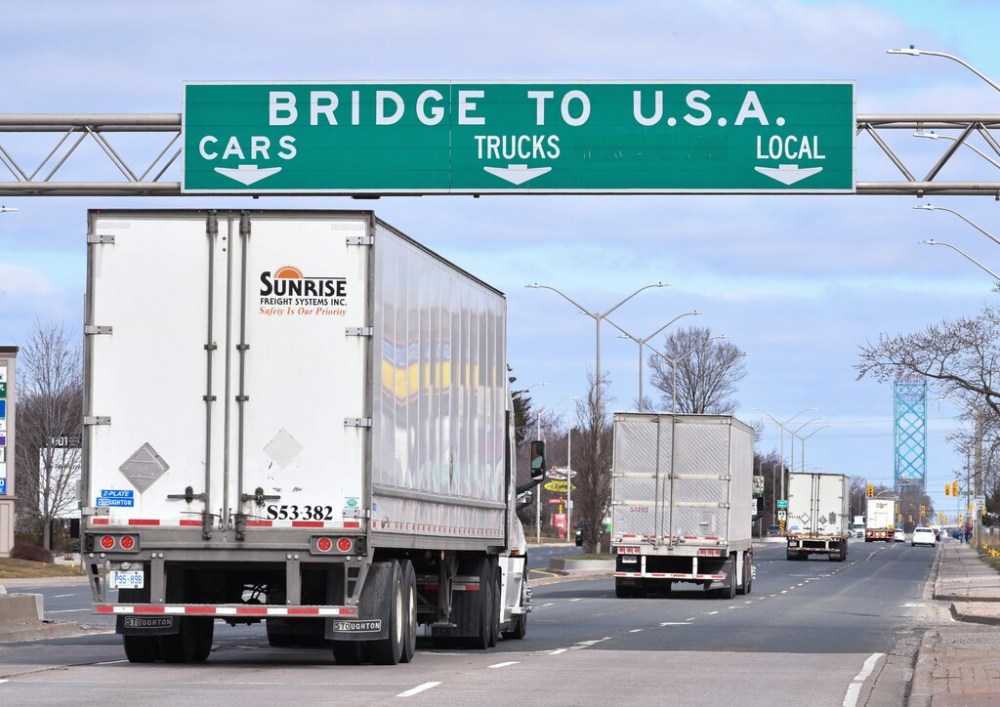Keeping U.S. border closed the easy call
Read this article for free:
or
Already have an account? Log in here »
To continue reading, please subscribe:
Monthly Digital Subscription
$0 for the first 4 weeks*
- Enjoy unlimited reading on winnipegfreepress.com
- Read the E-Edition, our digital replica newspaper
- Access News Break, our award-winning app
- Play interactive puzzles
*No charge for 4 weeks then price increases to the regular rate of $19.00 plus GST every four weeks. Offer available to new and qualified returning subscribers only. Cancel any time.
Monthly Digital Subscription
$4.75/week*
- Enjoy unlimited reading on winnipegfreepress.com
- Read the E-Edition, our digital replica newspaper
- Access News Break, our award-winning app
- Play interactive puzzles
*Billed as $19 plus GST every four weeks. Cancel any time.
To continue reading, please subscribe:
Add Free Press access to your Brandon Sun subscription for only an additional
$1 for the first 4 weeks*
*Your next subscription payment will increase by $1.00 and you will be charged $16.99 plus GST for four weeks. After four weeks, your payment will increase to $23.99 plus GST every four weeks.
Read unlimited articles for free today:
or
Already have an account? Log in here »
Hey there, time traveller!
This article was published 15/06/2020 (2003 days ago), so information in it may no longer be current.
A deeper dive into novel coronavirus infection numbers in the United States shows why the Canada-U.S. border shouldn’t open anytime soon.
The number of COVID-19 cases in many parts of the U.S. has soared over the past week, including Florida, Arizona and Texas. Case numbers were on the rise in 22 states as of Saturday, as many areas reopen large parts of their economies.
Florida saw its biggest daily jump of new cases since the beginning of the pandemic.
Case numbers alone aren’t the only thing to consider. Test positivity rates — the percentage of those tested who are infected — are even more important. While those numbers have been on the decline in the U.S., the rates south of the border are more than double what they are in Canada.
Public health officials look at the seven-day rolling average of test positivity rates as an important metric when analyzing the spread of the disease. In the U.S., as of Monday, the seven-day average was 4.5 per cent; it’s two per cent in Canada.
The numbers differ substantially between regions, just as they do in Canada.
Rates are far higher in Quebec and Ontario than they are in Manitoba, where test positivity rates have been well below one per cent for weeks. Likewise, the test positivity rates for the past seven days in Arizona (15.6 per cent) or Alabama (13.5 per cent) are well above Maine (2.05 per cent) or Vermont (0.6 per cent).
As of Monday, 35 states or regions (including Puerto Rico and District of Columbia) had test positivity rates below five per cent, while 17 had rates above that number.
The challenge for Canada: once the border is open to non-essential travel with the U.S., it can’t pick and choose which states it will accept travellers from. If it could limit travel between Canada and states such as Montana (0.49 per cent) and West Virginia (0.75 per cent), there would be far less risk. But that’s impossible.
Once the border reopens, people will travel from all areas of the U.S., including Texas, Arizona and Florida. It’s all or nothing.
Those travelling by car may also pass through multiple states, further raising the risk of infection.
Canada can currently limit travel between provinces and impose 14-day self-isolation rules, where needed. So far, those measures have worked well for provinces such as Manitoba and New Brunswick, which have far fewer cases than most other jurisdictions.
Manitoba is considering lifting self-isolation requirements with western provinces and northern parts of Ontario in Phase 3 of its reopening plans — but only because infection rates in those jurisdictions are relatively low.
Canada doesn’t have that luxury when it comes to the United States. Trying to enforce a 14-day self-isolation policy for millions of people travelling between Canada and the U.S. under an open-border scenario would be far more problematic.
It’s doubtful public health officials would be willing to roll the dice on that, which is why the federal government is expected to announce soon an extension of the border closure.
What Ottawa does need to decide, though, is where the epidemiology should be in the U.S. before it agrees to open the border to non-essential travel.
Should Canada stay closed until all states have test positivity rates below a certain level (such as five per cent)? Should it remain closed until all states have flattened their curve for a prescribed period?

Test positivity rates and overall case numbers may not be the only data the federal government considers, but there should be a specific plan in place (and the criteria used to be made public). These decisions should not be made on the fly.
Like all aspects of this pandemic, trying to find the right balance between the economy and protecting public health is no easy task.
But with the high rates of infection in many parts of the U.S. (and the growth of cases in some regions), keeping the border closed until further notice is the obvious choice.
tom.brodbeck@freepress.mb.ca

Tom has been covering Manitoba politics since the early 1990s and joined the Winnipeg Free Press news team in 2019.
Our newsroom depends on a growing audience of readers to power our journalism. If you are not a paid reader, please consider becoming a subscriber.
Our newsroom depends on its audience of readers to power our journalism. Thank you for your support.





